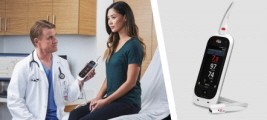NEUCHATEL, SWITZERLAND-- January 10, 2023 -- Masimo (NASDAQ: MASI) today announced the results of a prospective study published in the American Journal of Emergency Medicine in which Dr. Zohair Ahmed Ali Al Aseri and colleagues at King Saud University Medical City and Dar Al Uloom University (Riyadh, Saudi Arabia) evaluated the performance of noninvasive spot-check hemoglobin measurement with Masimo SpHb® on emergency department (ED) patients. The researchers found that SpHb provided “acceptable accuracy and excellent correlation” with their invasive laboratory measurements and offers an “easy, quick, feasible, cheap, and accurate solution for Hb measurement in the ED.
Noting that invasive blood hemoglobin measurement, while an important step in the management of blood loss, has drawbacks such as “consumption of valuable time, phlebotomy-induced anemia, pain, infection, and more involvement of human resources and equipment,” the authors sought to evaluate whether a noninvasive modality might offer similarly accurate results while mitigating some of these factors. To compare noninvasive and invasive measurements, they enrolled 650 patients (age > 14 years) who visited the EDs of two hospitals within King Saud University Medical City between March and May 2022 and needed complete blood count measurements. Hemoglobin was noninvasively measured (SpHb) using the Masimo Rad-67® handheld Pulse CO-Oximeter® with the DCI®-mini fingertip sensor. Simultaneously, blood samples were collected and analyzed at the time of collection (LabHb) using their automated analyzer, a UniCel DxH 800 Coulter Cellular Analysis System.
The researchers found a “highly significant correlation” between SpHb and LabHb (Pearson correlation coefficient = 0.812, p < 0.01). Bland-Altman analysis revealed low mean bias of 0.146 g/dL ± 1.39 g/dL, with moderate limits of agreement (-2.58 and 2.87 g/dL) and a margin of error (95% confidence interval) of 2.7 g/dL.
The researchers concluded that “noninvasive hemoglobin (SpHb) measurement showed acceptable accuracy and excellent correlation with LabHb and provided an easy, quick, feasible, cheap, and accurate solution for Hb measurement in the ED. Further research is required to study its effects on patient outcomes and blood transfusion and time and cost effectiveness.”
SpHb is not intended to replace laboratory blood testing. Clinical decisions regarding red blood cell transfusions should be based on the clinician’s judgment considering, among other factors, patient condition, continuous SpHb monitoring, and laboratory diagnostic tests using blood samples.






